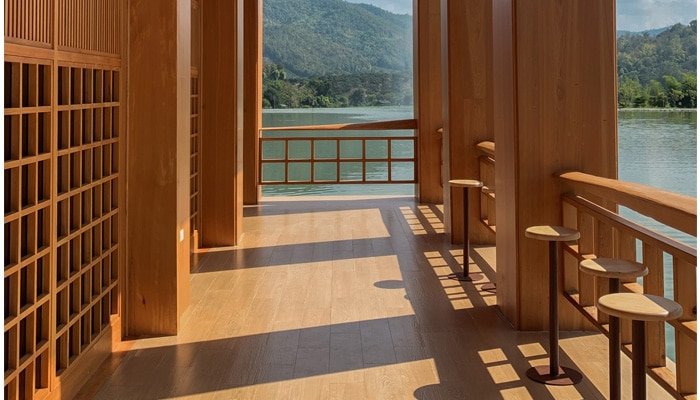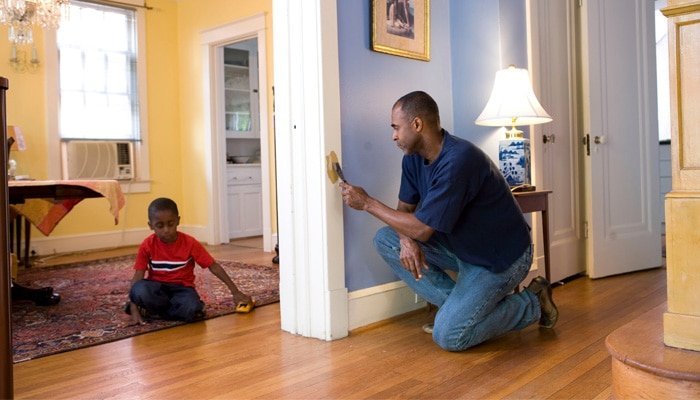The flooring in your home and apartment is one of its most prized features, so a quality laminate or solid hardwood floors will make it feel beautiful. Solid hardwood flooring is one of the more popular options on the market because of its natural look and its long lifespan.
Many older, traditional houses have the hardwood floors still on the ground, but some modern homes are gravitating toward flooring laminate.
In this article, we provide you a full comparison of laminate vs. solid hardwood flooring. We examine the key distinguishing features between the two quality flooring types.
We also give our recommendation on the best option to pick, based on the set of criteria. Our goal is to educate you on all the necessary information so that you can make an educated purchase decision.
Laminate vs. Solid Hardwood Flooring: Distinguishing Differences
The laminate vs. solid hardwood flooring debate is a passionate discussion that always requires a tough decision. Both types have their pros and cons, and when it comes to cost, laminate is usually the more cost-efficient option.
Solid hardwood floors consist of floorboards that are 100% solid hardwood. These boards are usually manufactured with a smoother top surface and edges that interlock through a tongue-and-groove system.
Laminate floors are created with a fiberboard core of wood byproducts, and then the design layer is replicated to a wood style. Laminate flooring is usually between ¼ and ½-inch thick.
But when it comes to appearance, solid hardwood provides a beautiful, aesthetic look that many people yearn for when designing their luxurious homes.
Solid hardwood’s lower-quality options will be better than some of the laminate’s most versatile options. Laminate will look like real hardwood from far away, but you will quickly be able to tell the artificial appearance from close.
| Appearance | Wood-like from long distance, but a low-quality replica of wood up close | Classic, authentic wood |
| Cost | $1-4 per square foot | $7-$23 per square foot |
| Installation | Floating floor | Nail gun or glue |
| Durability | Lifespan of 10-15 years | With proper care, can last up to 100 years or more |
| DIY installation | DIY is simple and straightforward | Professional installation required |
Durability
Laminate
Laminate flooring utilizes pressed wood for its surface, so it is usually resistant to scratches, wear and tear, or moisture.
This type of flooring can also provide durability because it is easier to clean and maintain, which allows it to retain its real quality for the long term. Laminate flooring is often a viable choice for homes with small children and pets.
Laminate is advantageous for your home because it will not need to get sanded over as frequently as traditional hardwood. Although laminate flooring is still susceptible to chips and dents, there are many laminate repair packages available for homeowners online.
Solid Hardwood
Solid hardwood’s durability depends on the type of wood, thickness, width, and finish. But most hardwood types can last you up to 100 years before needing to get it replaced.
Although it can sometimes get scratched, it can be sanded down or refinished several times. It is also much easier to treat when you spill certain liquids on it.
As you shop for the different types of solid hardwood for your home, you must understand each type’s durability. Softer options like pine will not be as long-lasting as more durable woods like mahogany or oak.
It is also recommended that your hardwood be resealed by a professional. Many solid hardwood types will wear down after you sand it more than four times, so keep this in mind with this option.
Best for Durability: Laminate
Laminate is the superior choice here because it has a higher resistance to fading. It is also comforting to know that it requires less sanding and refinishes over time.
For areas like the kitchen where staining is conventional, laminate will provide a more durable option. And because laminate uses pressed wood, it will be more resistant to dents over the long run.
If you want to know more about Kitchen flooring read this article: What is the Best Hardwood Floor for a Kitchen?

Water Resistance
Laminate
Laminate flooring and water do not mix well. When you consistently damage your laminate floor with water, it can lead to gapping, separating, warping, and buckling for your floors.
Although it is not a regular occurrence, some homeowners have complained about mold and mildew when using laminate floors.
Damage is especially prevalent when water seeps into the grooves between the planks. When this issue occurs, the fiberboard cores will chip and swell. When you decide the flooring in the wetter areas of your house like the bathrooms, you should try and stay away from laminate.
Solid Hardwood
Solid hardwood is a popular option in many home kitchens, but it is also not the smartest flooring option for water and spills. Although it is an easy cleanup for these issues, solid hardwood floors can get seriously harmed in the long run by floods and standing water.
You should also avoid installing hardwood near heating systems, which will cause the joints to heat up from shrinking boards.
Best for Water Resistance: Laminate
When you pick the best option for water resistance, you choose based on the lesser of two evils. Laminate is slightly a better option because it is more suitable for humid locations like near heating systems and concrete slabs. Laminate is also a much more durable and resistant option against heat and extreme temperatures.
Installation
Laminate
The installation process for laminate flooring is simple and straightforward. Before you begin installing, you will need to apply an underlayment to the subfloor. Some laminate floor options will already come with this attached, but it is designed to provide padding to improve acoustics in the room.
Unlike solid hardwood, laminate is a tongue & groove system, which provides a “floating floor.”
That way, you will not need any application of nails or glue. Although the installation process can be long and dragged out, many homeowners can complete it within one day.
Solid Hardwood
Solid hardwood installation is a much more complicated process for DIY homeowners to install. You will need to obtain a floor stapler or nail gun to get the job done.
Some solid hardwood boards will come unfinished, so a professional will need to refinish and sand before installing the planks. This type of flooring also uses tongue & groove, but you will need to focus more on subfloor selection and preparation.
Best for Installation: Laminate
Although the installation processes are somewhat similar, the laminate flooring is more uncomplicated and more straightforward for DIY installers.
There is also a chance that hardwood floors will need to be refinished and sanded before installing. Laminate flooring does not come with this extra step.
Cost
Laminate
Laminate flooring is much more affordable than solid hardwood. The typical range for most laminate flooring manufacturers run between $1-$4 per square foot.
Some of the more expensive, designer flooring types will go around $11-$13 per square foot. The thicker the layers are in the laminate flooring, the higher price you will pay.
Solid Hardwood
When you decide to invest in solid hardwood for your floors, you should anticipate paying anywhere in the $7-$23 per square foot range, before installation costs.
Higher-quality wood types like walnut and ash will be more expensive, between $15-$23 per square foot. Woods of lesser quality like maple, bamboo, and pine will run on the lower side, around $7-$13 per square foot. If you are trying to sell a house, keep in mind that you will always get better resale value with solid hardwood.
Read our article on most economical alternatives of hardwood flooring here: What Type of Wood Floor is the Most Economical?
Best for Cost: Laminate
Laminate flooring has a transparent edge here because of the lesser price point. Even the higher-quality laminate flooring types are still at lower prices for the solid hardwood flooring.

Cleanliness & Care
Laminate
Laminate flooring is straightforward to maintain and keep clean, but there are a few safety precautions you should know to avoid damaging the floor.
When it comes to daily messes, you should utilize a broom, vacuum cleaner, or dust mop to clean it up. If there is any water that gets on the floor, you should also clean it up immediately to avoid further damage.
You should also avoid cleaning the laminate floor with a wet mop at all costs. You should focus only on using soap-free cleansers, which you can spray and wipe with a cloth. Because laminate floors retain its shine and aesthetic over time, you will not need to wax it.
Solid Hardwood
Solid hardwood is much more natural to clean than laminate flooring. The cleaning process is straightforward because you can either vacuum or sweep.
If you utilize a wood cleaner or polish, you can also treat the floor by damp mopping it. Most of the modern floors get sealed with polyurethane, and they are never waxed or polished.
Best for Maintenance & Care: Solid Hardwood
Although both floor types are easy to care for, solid hardwood does not have as many precautions. You can implement the same cleaning styles, but you can also treat it with different types of mopping.
Verdict
It is tough to pick the best option between solid hardwood and laminate flooring, but we must go with the hardwood flooring.
Because of its authenticity and prestigious appearance for modern homes, it is a much more attractive option for homeowners. Hardwood floors are also much more resistant to water and dents, making it a long-lasting choice for up to 100 years. If you want more option check out our Carpet vs. Hardwood Flooring article.

